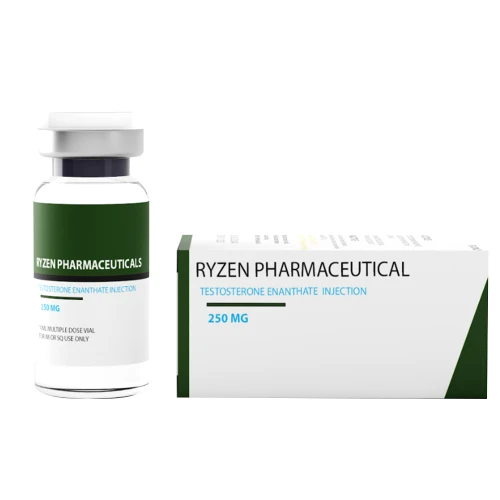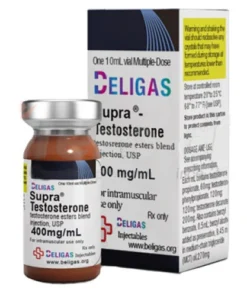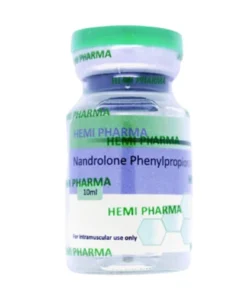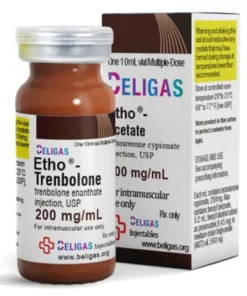Testosterone Enanthate
$85.00
Testosterone Enanthate
Testosterone enanthate is a testosterone replacement therapy testosterone-replacement-options-for-treatment-have-just-gotten-better. testosterone-replacement-options-for-treatment-have-just-gotten-better It’s mainly used in males to treat low testosterone levels and delayed puberty It’s also FDA-approved in females for treating metastatic breast cancer but it’s not a first-choice option for this condition. Testosterone enanthate is given as a deep injection into the muscle of the buttock, typically every 2 to 4 weeks by a healthcare professional (HCP). Side effects can include acne and pain or swelling at the injectio.
WHAT IS TESTOSTERONE ENANTHATE USED FOR?
• Low testosterone hypogonadism in males
• Delayed puberty in males
• Metastatic breast cancer that have spread to the bones in females who’ve started menopause in the past 1 to 5 years
How Testosterone enanthate works
Testosterone enanthate is a testosterone replacement therapy that acts like the natural sex hormone, testosterone. Testosterone (https://www.yourhormones.info/hormones/testosterone/) is responsible for the development and maintenance of many male features and functions, such as muscle and bone strength and growth and regulating sex drive and sperm production.
• For low testosterone and delayed puberty: Testosterone enanthate works by raising testosterone to normal and healthy levels in males with low testosterone.
• For breast cancer: It’s not exactly clear how testosterone enanthate works to treat breast cancer, but it’s thought to slow the spread of the cancer in females by stopping tumor growth
WHAT ARE THE RISK ASSOCIATED WITH TAKING TESTOTERONE ENANTHATE?
Testosterone enanthate can cause some serious health issues. This risk may be even higher for certain groups. If this worries you, talk to your doctor or pharmacist about other options.
Risk of blood clots, including heart attack or stroke
• Risk factors: History of heart conditions
Taking testosterone replacement therapy can raise your risk of blood clots. This can lead to problems such as strokes and heart attacks. Your healthcare team will have you perform regular blood tests, called the complete blood count (CBC) to check that your blood cell counts are in the safe range. Get emergency help right away if you have chest pain, cold sweats, left arm pain, difficulty breathing, trouble walking, trouble speaking, or weakness on one side of the body, since you might have to stop taking the medication.
Prostate problems
Testosterone enanthate might raise the risk for enlarged prostate and prostate cancer in males. Symptoms include pain, inability to urinate or change in the amount of urination, and blood in the urine. If you notice any of these symptoms, talk to your prescriber right away before it becomes worse.
Potential for misuse, dependency, and addiction
• Risk factors: Taking more testosterone enanthate than prescribed | Taking testosterone enanthate with other testosterones
Testosterone enanthate is a controlled substance because it has a risk of misuse and dependency, especially if you use higher doses than prescribed or use it with other testosterones.
Continued misuse of testosterone enanthate can lead to addiction The FDA has only approved this medication for the treatment of low testosterone and delayed puberty in males and breast cancer in certain females. Taking testosterone enanthate for other reasons can lead to serious side effects, such as heart attack, heart failure, stroke depression, hallucinations, and delusions. Only take testosterone enanthate as prescribed by your healthcare professional.
Liver problems
• Risk factors: Using high doses of testosterone enanthate long term
Using testosterone enanthate for long periods of time can cause life-threatening liver problems Your HCP will order blood tests to check your liver enzymes to make sure they’re not getting too high. Let your care team know if you’re experiencing stomach pain, light-colored stools, dark urine, or if your skin or the whites of your eyes turn yellow because you might need to stop the medication.
Low sperm count
• Risk factors: Higher doses of testosterone enanthate
Testosterone enanthate can lower sperm count, which might affect your ability to have a baby (fertility). There’s a chance these effects can be permanent. Let your prescriber know if you’re thinking of having a baby before you start testosterone enanthate.
Swelling in the legs or arms (edema)
• Risk factors: History of heart, liver, or kidney conditions | Taking other medications that cause swelling like corticosteroids
Testosterone enanthate can cause your body to hold onto more salt and water, which can lead to swelling in your legs or arms and sudden weight gain. This is more likely to happen if you’re taking other medications that cause swelling, such as corticosteroids. It can be more serious in people with heart, liver, or kidney conditions. Talk to your HCP if you have any of these symptoms because you might need to stop the medication.
High calcium levels in the blood
• Risk factors: Females with breast cancer | People with restricted movement | Taking other medications that cause high calcium in the blood
Testosterone enanthate can cause high calcium in the blood because it triggers break down of bone tissue. The risk is higher for people who have cancer or people who take medications that raise calcium levels In people with cancer, high calcium levels might be a sign that the cancer has spread to the bones. During treatment with testosterone enanthate, your healthcare team might order regular blood tests to check that your calcium levels are within a safe range.
Fast bone maturation in children
• Risk factors: Using testosterone enanthate in children | Using testosterone enanthate long term
Testosterone enanthate should only be used short term for delayed puberty in children. The medication causes the bones to mature faster than normal, but without growth in length. Because of this, children who use testosterone enanthate can become shorter in height if used long term. The risk of this happening is higher in younger children. Your child’s pediatrician might take regular X-rays of your child’s hand and wrist during treatment to make sure the bones are developing normally.
Severe allergic reactions
• Risk factors: Allergy to sesame oil
Severe allergic reactions to testosterone enanthate are possible, including life-threatening reactions, like facial swelling and anaphylaxis. Since testosterone enanthate contains sesame oil, you shouldn’t use the medication if you have an allergy to sesame. Let your prescriber know before starting testosterone enanthate if you have this type of allergy. Call 911 right away if you experience hives, rash, trouble breathing, or swelling of your face, lips, or throat.
WHAT ARE THE SIDE EFFECTS OF TESTOSTERONE ENANTHATE?
The following side effects may get better over time as your body gets used to the medication. Let your healthcare provider know immediately if you continue to experience these symptoms or if they worsen over time.
Common Side Effects
Males
• Enlargement of male breasts
• Acne
• More erections
• Pain at the injection site
Females
• Deepening of the voice
• Acne
• Absence of or irregular menstrual periods
• More hair on the face and body
• Pain at the injection site
Other Side Effects
• Bleeding or blood clots
• Changes in sex drive
• Tingling sensation
• Headache
• Anxiety
• Depression
• Nausea
Serious Side Effects
Contact your healthcare provider immediately if you experience any of the following.
• Severe allergic reaction: hives, rash, blisters, swelling of the lips or tongue, difficulty breathing,
• Heart attack: chest pain, cold sweats, left arm pain, difficulty breathing
• Stroke: face drooping, trouble seeing, walking, or speaking, weakness on one side of the body
• Blood clot in the legs: pain, swelling, warm to touch, redness in the leg
• Blood clot in the lungs: trouble breathing, chest pain, cough
• Liver damage: stomach pain, nausea, vomiting, yellowing of the skin, yellowing of the whites of the eyes, light-colored stools, dark urine, weight loss
• Withdrawal: depression, fatigue, craving, restlessness, irritability, lack of appetite, trouble sleeping (insomnia), lower sex.
Background
Testosterone enanthate is an esterified variant of testosterone that comes as an injectable compound with a slow-release rate. This slow release is achieved by the presence of the enanthate ester functional group attached to the testosterone molecule.2 This testosterone derivative was first approved on December 24, 1953.10
In 2017, about 6.5 million retail prescriptions for testosterone therapy were filled 9. The majority of the prescriptions written were for injectable (66%) and topical (32%) testosterone products. As recent as 1 October 2018, the US FDA approved Antares Pharma Inc.’s Xyosted – a subcutaneous testosterone enanthate product for once-weekly, at-home self-administration with an easy-to-use, single dose, disposable autoinjector 9. As the first subcutaneous autoinjector product designed for testosterone replacement therapy, this innovative formulation removes transfer concerns commonly associated with testosterone gels and potentially reduces the need for in-office/in-clinic injection procedures that may inconvenience patients with frequent visits to the clinic 9.
Indication
Testosterone enanthate in males is indicated as a replacement therapy in conditions associated with a deficiency or absence of endogenous testosterone. Some of the treated conditions are 1) primary hypogonadism, defined as testicular failure due to cryptorchidism, bilateral torsion, orchitis, vanishing testis syndrome or orchidectomy; 2) hypogonadotropic hypogonadism due to an idiopathic gonadotropin or luteinizing hormone-releasing hormone deficiency or due to a pituitary-hypothalamic injury from tumors, trauma or radiation, in this case it is important to accompany the treatment with adrenal cortical and thyroid hormone replacement therapy; 3) to stimulate puberty in patients with delayed puberty not secondary to a pathological disorder. If the conditions 1 and 2 occur prior to puberty, the androgen replacement therapy will be needed during adolescent years for the development of secondary sexual characteristics and prolonged androgen treatment might be needed it to maintain sexual characteristics after puberty.Label
In females, testosterone enanthate is indicated to be used secondarily in presence of advanced inoperable metastatic mammary cancer in women who are from one to five years postmenopausal. It has also been used in premenopausal women with breast cancer who have benefited from oophorectomy and are considered to have a hormone-responsive tumor.Label
Testosterone enanthate injections that are currently formulated for subcutaneous use are specifically indicated only for primary hypogonadism and hypogonadotropic hypogonadism 11. The use of such formulations is limited because the safety and efficacy of these subcutaneous products in adult males with late-onset hypogonadism and males less than 18 years old have not yet been established 11. Moreover, subcutaneously administered testosterone enanthate is indicated only for the treatment of men with hypogonadal conditions associated with structural or genetic etiologies, considering the medication could cause blood pressure increases that can raise the risk of major adverse cardiovascular events like non-fatal myocardial infarction, non-fatal stroke, and cardiovascular death 11.
Pharmacodynamics
Administration of ester derivatives of testosterone as testosterone enanthate generates an increase in serum testosterone to levels reaching 400% from the baseline within 24 hours of administration. These androgen levels remain elevated for 3-5 days after initial administration.5 Continuous administration of testosterone enanthate shows a significant suppression of dihydrotestosterone, serum PSA, HDL and FSH, as well as a slight increase in serum estradiol. The levels of dihydrotestosterone and FSH can remain suppressed even 14 days after treatment termination. There are no changes in mood and sexual activity by the presence of testosterone enanthate.
Mechanism of action
The effects of testosterone in humans and other vertebrates occur by way of two main mechanisms: by activation of the androgen receptor (directly or as DHT), and by conversion to estradiol and activation of certain estrogen receptors. Free testosterone (T) is transported into the cytoplasm of target tissue cells, where it can bind to the androgen receptor, or can be reduced to 5α-dihydrotestosterone (DHT) by the cytoplasmic enzyme 5α-reductase. DHT binds to the same androgen receptor even more strongly than T, so that its androgenic potency is about 2.5 times that of T. The T-receptor or DHT-receptor complex undergoes a structural change that allows it to move into the cell nucleus and bind directly to specific nucleotide sequences of the chromosomal DNA. The areas of binding are called hormone response elements (HREs), and influence transcriptional activity of certain genes, producing androgen effects.1
Such activities are useful as endogenous androgens like testosterone and dihydrotestosterone are responsible for the normal growth and development of the male sex organs and for maintenance of secondary sex characteristics 11. These effects include the growth and maturation of the prostate, seminal vesicles, penis, and scrotum; the development of male hair distribution, such as facial, pubic, chest, and axillary hair; laryngeal enlargement, vocal cord thickening, and alterations in body musculature and fat distribution 11.
Male hypogonadism, a clinical syndrome resulting from insufficient secretion of testosterone, has two main etiologies 11. Primary hypogonadism is caused by defects of the gonads, such as Klinefelter’s syndrome or Leydig cell aplasia, whereas secondary hypogonadism is the failure of the hypothalamus (or pituitary) to produce sufficient gonadotropins (FSH, LH) 11.
Absorption
The pharmacokinetic profile of testosterone enanthate was studied in a regime of multiple dosing and the testosterone level was reported to present a Cmax above 1200 ng/dl after 24 hours of the last dose. The concentration decreased sequentially until it reached 600 ng/dl after one week. The pharmacokinetic profile of testosterone enanthate presented differences depending on the administered dose in which the tmax was shifted to a range of 36-48 hours. The plasma testosterone level plateaued below the therapeutic range after 3-4 weeks. This reports showed that the different formulation of testosterone enanthate and testosterone cypionate generates a different profile and thus, they are not therapeutically equivalent.
Volume of distribution
The volume of distribution following intravenous administration of testosterone is of approximately 1 L/kg.8
Protein binding
Circulating testosterone is primarily bound in serum to sex hormone-binding globulin (SHBG) and albumin. Approximately 98% of testosterone in plasma is bound to SHBG while 2% remains unbound (i.e. free).10
Metabolism
To start its activity, testosterone enanthate has to be processed by enzymes in the bloodstream. These enzymes will catalyze the molecule at the ester location of the moiety. Once processed in this manner, the testosterone enanthate molecule is metabolized to various 17-keto steroids through two different pathways. Subsequently, the major active metabolites are estradiol and DHTd. Testosterone is metabolized to DHT by steroid 5α-reductase in skin, liver and urogenital tract. In reproductive tissues DHT is further metabolized to androstanediol.7,11
Testosterone enanthate
Testosterone
Dihydrotestosterone
3-alpha-Androstanediol glucuronide
Route of elimination
About 90% of a dose of testosterone given intramuscularly is excreted in the urine as glucuronic and sulfuric acid conjugates of testosterone and its metabolites; about 6% of a dose is excreted in the feces, mostly in the unconjugated form.7, The inactivation of testosterone occurs primarily in the liver.
Toxicity
Testosterone enanthate has been tested in preclinical carcinogenesis trials. In this studies, it is suggested that the exposure to this drug may increase the susceptibility to hematoma as well as the number of tumors and decrease the degree of differentiation of chemically induced carcinomas of the liver. Label
Testosterone enanthate is not indicated for use in females and is contraindicated in pregnant women. Testosterone is teratogenic and may cause fetal harm when administered to a pregnant woman based on data from animal studies and its mechanism of action.
During treatment with large doses of exogenous androgens, including testosterone enanthate, spermatogenesis may be suppressed through feedback inhibition of the hypothalamic-pituitary-testicular axis. Reduced fertility is observed in some men taking testosterone replacement therapy and the impact on fertility may be irreversible .
Safety and effectiveness of testosterone enanthate in pediatric patients less than 18 years old have not been established . Improper use may result in the acceleration of bone age and premature closure of epiphyses.
Geriatric patients treated with androgens may also be at risk for worsening of signs and symptoms of Benign Prostatic Hyperplasia
Be the first to review “Testosterone Enanthate” Cancel reply
Related products
Injectable steriods
Injectable steriods
Injectable steriods
Injectable steriods
Injectable steriods
Injectable steriods
Injectable steriods
Injectable steriods












Reviews
There are no reviews yet.